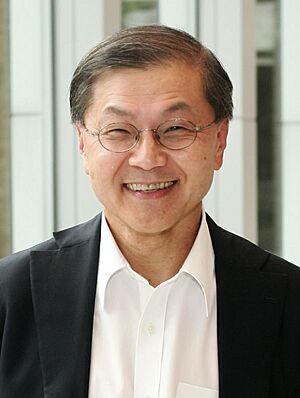David Ho facts for kids
Quick facts for kids
David Ho
|
|||||||||||||||||
|---|---|---|---|---|---|---|---|---|---|---|---|---|---|---|---|---|---|
| 何大一 | |||||||||||||||||

Ho in 2012
|
|||||||||||||||||
| Born | November 3, 1952 |
||||||||||||||||
| Education | California Institute of Technology (BS) Harvard University (MD) |
||||||||||||||||
| Known for | HIV/AIDS research | ||||||||||||||||
| Awards | Ernst Jung Prize (1991) Bristol-Myers Squibb Award (1996) American Academy of Arts and Sciences (1997) Presidential Citizens Medal (2001) |
||||||||||||||||
| Scientific career | |||||||||||||||||
| Fields | Virology | ||||||||||||||||
| Institutions | Columbia University Rockefeller University |
||||||||||||||||
| Chinese name | |||||||||||||||||
| Chinese | 何大一 | ||||||||||||||||
|
|||||||||||||||||
David Da-i Ho (Chinese: 何大一; pinyin: Hé Dà-yī; born November 3, 1952) is a famous Taiwanese-American scientist. He is a doctor and a virologist, which means he studies viruses. Dr. Ho has made huge contributions to understanding and treating HIV infection, the virus that causes AIDS.
He was a pioneer in using "combination therapy" for HIV. This means using several medicines together instead of just one. This important change helped turn HIV from a deadly disease into a manageable long-term condition.
David Ho was born in Taiwan in 1952. He moved to the United States in 1965. He studied at the California Institute of Technology and then earned his medical degree from Harvard Medical School.
Today, he is the founding scientific director of the Aaron Diamond AIDS Research Center. He is also a professor at Columbia University Vagelos College of Physicians and Surgeons. Both are part of the Columbia University Irving Medical Center.
Early Life and Education
David Ho was born in Taichung, Taiwan. His father, Paul, was an engineer, and his mother was Sonia Ho. David went to elementary school in Taiwan until the sixth grade.
In 1965, he moved to the United States with his mother and younger brother. They joined his father, who had already been living in the U.S. since 1957.
Ho grew up in Los Angeles. He graduated from John Marshall High School. He then earned his Bachelor of Science degree in biology from the California Institute of Technology in 1974. In 1978, he received his medical degree (M.D.) from Harvard Medical School.
Career and Discoveries
Dr. Ho has been involved in HIV/AIDS research since the very beginning of the AIDS outbreak. He first focused on how the HIV virus works and how it becomes resistant to medicines.
Before 1996, doctors used only one medicine, like AZT, to treat HIV. This single medicine often did not stop the disease from getting worse and leading to full-blown AIDS.
In the mid-1990s, Dr. Ho's research team did important studies. They learned how HIV copies itself inside the body. This knowledge helped them develop a new way to treat HIV. They decided to treat HIV "early and hard" using "combination antiretroviral therapy." This meant using several strong medicines at once.
In 1996, Dr. Ho and his team at ADARC shared their amazing results at the International AIDS Conference 1996. This was a huge moment! It changed HIV from a disease that almost always led to death into a manageable condition.
As of February 2020, Dr. Ho has published more than 500 research papers. He is also a member of the Committee of 100, a group of Chinese American leaders.
More recently, Dr. Ho led a team that looked for a vaccine for the COVID-19 virus. This work was supported by the Jack Ma Foundation.
Honors and Awards
David Ho has received many important honors for his scientific work.
In 1996, Time magazine named him their Man of the Year. Time magazine said that while he wasn't a household name, "some people make headlines while others make history." He was chosen because his work changed the future for millions of people.
In 1998, he received the Golden Plate Award from the American Academy of Achievement. In 2000, he was asked to give the graduation speeches at top universities like Caltech, MIT, and Harvard T. H. Chan School of Public Health.
On January 8, 2001, President Clinton gave him the Presidential Citizens Medal. This is one of the highest awards a civilian can receive in the U.S.
In 2006, the California governor and First Lady put Dr. Ho into the California Hall of Fame. This is located at The California Museum for History, Women, and the Arts.
The California Institute of Technology gave him their Distinguished Alumni Award in 2015. In 2017, he received the Portrait of a Nation Prize at the National Portrait Gallery.
Other awards include the Ernst Jung Prize in Medicine and the Mayor's Award for Excellence in Science & Technology.
Dr. Ho is a member of several important scientific groups. These include the American Academy of Arts and Sciences and the U.S. National Academy of Medicine. He is also on the board of trustees for the California Institute of Technology.
He was also recognized by the Kingdom of Thailand with the Prince Mahidol Award in Medicine. In 2022, he received the Hamdan Award for Medical Research Excellence.
Personal Life
David Ho's family comes from Xinyu, Jiangxi Province in China. He is married to Tera Wong. They have four children: Kathryn, Jonathan, Jaclyn, and Jerren.
See also
 In Spanish: David Ho para niños
In Spanish: David Ho para niños
- Treatment of HIV/AIDS
- International AIDS Conference 1996
- Aaron Diamond AIDS Research Center
- Chinese Americans in New York City
- Taiwanese Americans in New York City

